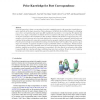Free Online Productivity Tools
i2Speak
i2Symbol
i2OCR
iTex2Img
iWeb2Print
iWeb2Shot
i2Type
iPdf2Split
iPdf2Merge
i2Bopomofo
i2Arabic
i2Style
i2Image
i2PDF
iLatex2Rtf
Sci2ools
CGF
2011
2011
Prior Knowledge for Part Correspondence
Classical approaches to shape correspondence base their computation purely on the properties, in particular geometric similarity, of the shapes in question. Their performance still falls far short of that of humans in challenging cases where corresponding shape parts may differ significantly in geometry or even topology. We stipulate that in these cases, shape correspondence by humans involves recognition of the shape parts where prior knowledge on the parts would play a more dominant role than geometric similarity. We introduce an approach to part correspondence which incorporates prior knowledge imparted by a training set of pre-segmented, labeled models and combines the knowledge with content-driven analysis based on geometric similarity between the matched shapes. First, the prior knowledge is learned from the training set in the form of per-label classifiers. Next, given two query shapes to be matched, we apply the classifiers to assign a probabilistic label to each shape face...
| Added | 25 Aug 2011 |
| Updated | 25 Aug 2011 |
| Type | Journal |
| Year | 2011 |
| Where | CGF |
| Authors | Oliver van Kaick, Andrea Tagliasacchi, Oana Sidi, Hao Zhang 0002, Daniel Cohen-Or, Lior Wolf, Ghassan Hamarneh |
Comments (0)

